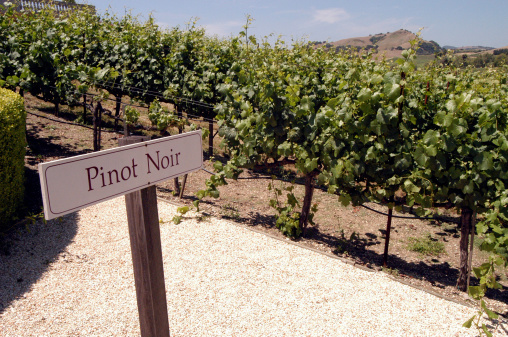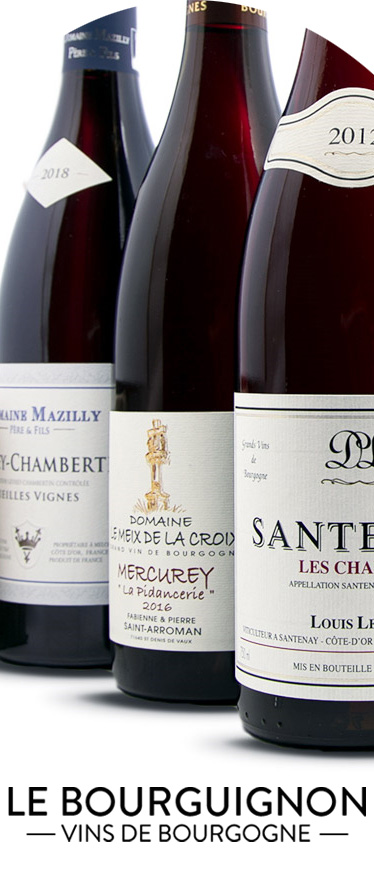All Burgundy vineyards producing red wines with a controlled designation of origin (AOC) located in the departments of Yonne, Côte-d'Or and Saône-et-Loire (29%).
The vine produces grapes and the juice of its grapes is transformed into wine !
In order to produce quality wines, the factors are several:
- the grape variety (variety of vine plant, from the Vitaceae family)
- the terroir (the nature of the soil, the place where the grape variety will be planted)
- climate (weather circumstances)

As you know, the great grape variety of Burgundy used in the production of red wine is Pinot Noir.
A very large part of Burgundy wines are monovarietals (i.e. only one grape variety is used during the elaboration of the wine).
Which grape variety in Burgundy?
The percentage of thegrape varieties in red:
- Pinot Noir: 36%
- Gamay: 11%
- Caesar : 0.6%
The secret of the king grape variety of Burgundy
- Le Pinot Noir
The Pinot Noir grape variety is purplish black in color, composed of small grains with thin, colorless and sweet skin. It is at the time of maceration and fermentation in vats, that the coloring matter contained in the skin of the grape berries, gives the wine its pretty red hue.
Pinot Noir particularly likes the calcareous, stony and marly soils of Burgundy, its temperate latitude and its semi-continental climate. This grape variety is grown mainly in the vineyards of the Côte de Nuits, the Côte de Beaune and the Côte Chalonnaise.
The Côte de Nuits vineyard extends over 8 villages renowned for the power and breed of their great red wines : Marsannay, Fixin, Gevrey-Chambertin, Morey-Saint-Denis, Chambolle-Musigny, Vougeot, Vosne-Romanée and Nuits-Saint-Georges. This vineyard also produces round and fruity Côtes de Nuits-Villages.
The Côte de Beaune vineyard covers 17 villages : Aloxe-Corton, Ladoix, Pernand-Vergelesses, Corton, Savigny-Lès-Beaune, Chorey-Lès-Beaune, Beaune, Meursault, Pommard, Volnay, Auxey-Duresses, Monthélie, Saint-Aubin, Puligny-Montrachet, Chassagne-Montrachet, Santenay and Maranges. Each appellation is complex for our greatest pleasure.
The vineyards of the Côte Chalonnaise extend over 5 villages, 3 of which produce red wine: Rully, Mercurey and Givry. All three offer wines of character and excellent value for money.
This grape variety offers very beautiful wines, all different depending on their terroir. During the tasting we discover a nice aromatic bouquet, with notes of red fruits (strawberry, raspberry, blackberry, cherry, cherry,…), floral notes (peony, violet, old rose,…), empyreumatic notes (tobacco, toast, smoked,…) and vegetal notes (hay, wet leaf, undergrowth, fresh mushroom,…). During the appetizer we appreciate its subtlety, its elegant tannins and its freshness.
The great red wines of Burgundy have a very good aging capacity, even after thirty years of bottle you feel an intense emotion during the tasting.
Secondary grape varieties
-
The Gamay
Gamay represents 11% of the vineyard area of Burgundy, since in 1395 Philippe Le Hardi Duc de Bourgogne banned the production of the Gamay grape variety and replaced it with Pinot Noir, reputed to be more qualitative and visibly more adapted to the climates of Burgundy.
Philip the Hardy drove the Gamay out of Burgundy, Prieuré-Roch reintroduced it! @lesvinsnaturels @bourgognespress pic.twitter.com/5I7OV6Rzdl
— Frédéric DurandBazin (@FDurandBazin) April 5, 2016
This grape variety is planted mainly in the Mâconnais on acidic and granitic soils. It is a fairly fertile plane whose clusters are medium and compact, of purple color that pulls on the blue.
Gamay wines produce fruity red wines with aromas of red fruits (currant, cherry, strawberry, raspberry,…) and black fruits (blackcurrant, blackberry, blueberry,…), on the palate light, pleasant and a beautiful acidity.
After a few years of aging, the wine evolves, dark ruby color, with notes of prune and spicy. In the mouth the tannins are silky and pleasant. It goes perfectly with cold cuts, rabbit or andouillettes.
=> Some appellations such as Mâcon, Bourgogne Passe-Tout-Grains, Coteaux Bourguignons and Crémants de Bourgogne are produced from two grape varieties , Gamay and Pinot Noir, to provide colour and aromas of red fruits.
-
The Caesar
The Caesar grape variety, also called Roman, gros noir or picorniot, is present in the Yonne only (this corresponds to less than 1% of the vineyard area of Burgundy).
This grape variety is used in the production of red wines but it can only represent 10% of the grape varieties.
Here are the different appellations authorizing the Caesar grape variety :
- Burgundy Chitry
- Burgundy Côte Saint-Jacques
- Burgundy Côtes d'Auxerre
- Burgundy Coulanges la Vineuse
- Burgundy Epineuil
- Irancy
- Burgundy Hillsides
The Caesar grape variety is associated with Pinot Noir to bring color or a red to the imperial purple. On the palate a more pronounced fruity side ( red fruits and black fruits), a surprising wine and very beautiful tannins.
Good tasting! 🍷



